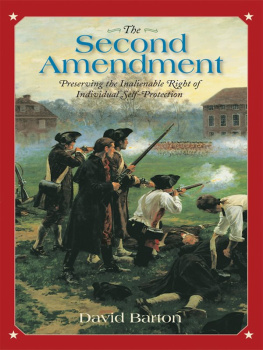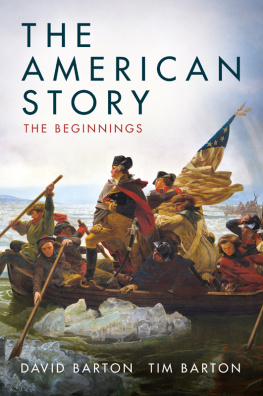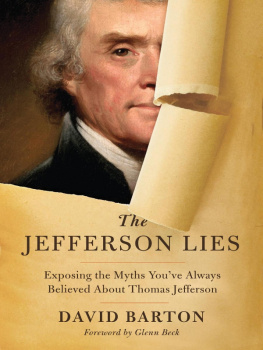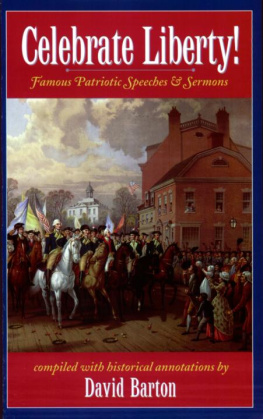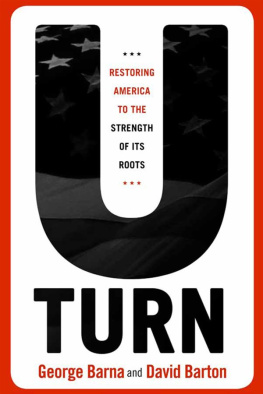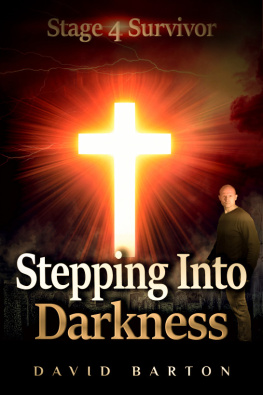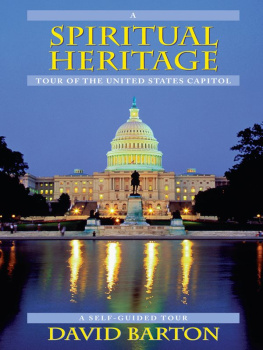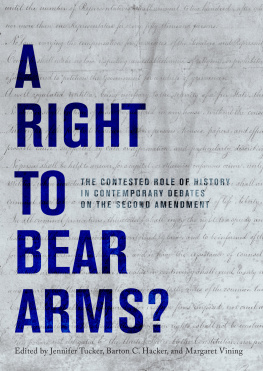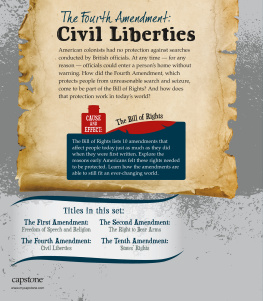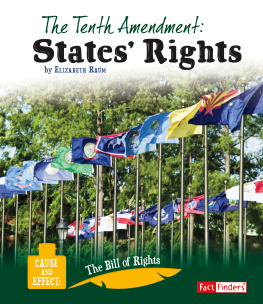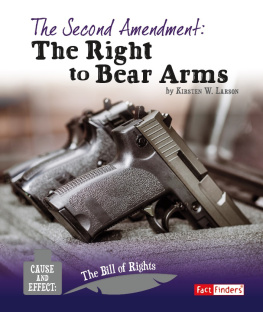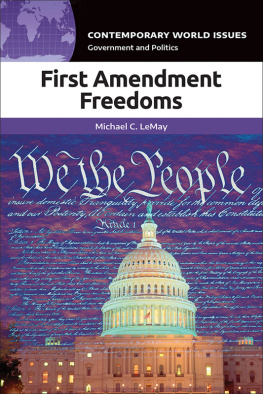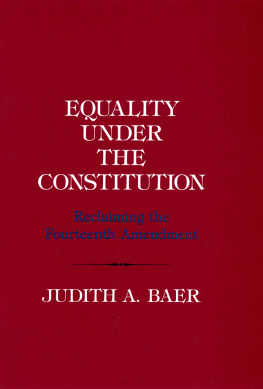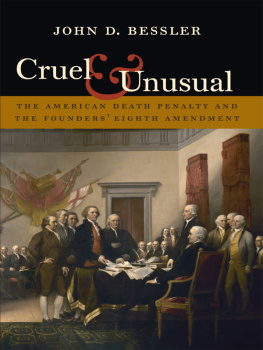
The Second Amendment: Preserving the Inalienable Right of Individual Self-Protection
Copyright 2000, David Barton
1st Edition, 4th Printing, 2011
All rights reserved. No part of this book may be reproduced in any manner whatsoever without written permission from the publisher, except in the case of brief quotations in articles and reviews.
Additional materials available from:
WallBuilders
P. O. Box 397
Aledo, TX 76008
(817) 441-6044
www.wallbuilders.com
Cover Painting:
Battle of Lexington, April 19, 1775. Oil on canvas by William Barnes Wollen (1857-1936), 1910.
Courtesy of the Director, National Army Museum, London
Cover Design:
Jeremiah Pent
Lincoln-Jackson
838 Walden Dr.
Franklin, TN 37064
Printed in the United States of America
Table of Contents
The Second Amendment
Preserving the Inalienable Right of
Individual Self-Protection
T he Second Amendment has become one of the most controversial parts of the Constitution. That Amendment, written in 1789 by the First Congress and ratified in 1791 by the States as part of the original Bill of Rights, states:
A well regulated militia being necessary to the security of a free state, the right of the people to keep and bear arms shall not be infringed.
The meaning of the right to keep and bear arms, and the segment of the citizenry to which that right applies, has been heatedly and vociferously debated in recent years. Specifically, what does people mean? Does people refer to the collective body (the militia) or does people refer to every citizen individually?
While gun rights supporters assert that the right to keep and bear arms is an individual right like the freedom of speech or religion, gun opponents assert that the right pertains only to collective bodies (e.g., the military, police, National Guard, etc.) and not to individuals. According to gun opponents:
[T]here is no individual right to bear arms in the Bill of Rights. USA Today (emphasis added)
[L]aw-abiding Americans have no unconditional right to firearms access. New York Post (emphasis added)
The debate over gun control offers a revealing case study of the misuse of the Constitution.... [T]he idea that the Bill of Rights guarantees each individual a right to own a gun.... [is] a constitutional illusion. The San Francisco Barrister
[T]he sale, manufacture, and possession of handguns ought to be banned.... [W]e do not believe the 2nd Amendment guarantees an individual right to keep them. The Washington Post
Austin American Statesman (emphasis added)
Believing that the Constitution offers no protection for individual gun ownership, gun opponents therefore encourage efforts to restrict or ban citizen access to firearms, particularly handguns. They frequently utilize highly-publicized, tragic instances of violence (such as those at Columbine, Fort Worth, Seattle, etc.) to bolster their argument that guns should be left only in the hands of professionals. For example:
There is no reason for anyone in the country, for anyone except a police officer or a military person, to buy, to own, to have, to use, a handgun. Michael Gartner, former president of NBC News
[T]he Second Amendment... protects only the right to bear arms for the purpose of service in the militia, and... not... firearm ownership unrelated to militia service. Statement filed by fifty-two law professors and historians in a Second Amendment lawsuit (emphasis added)
[T]he individuals right to bear arms applies only to the preservation or efficiency of a well-regulated militia. Except for lawful police and The ACLU (emphasis added)
One of the few things on which both gun rights supporters and gun rights opponents agree is that law enforcement officials, the militia, and the military do have the right to keep and bear arms. Therefore, this work will examine the contested scope of the Second Amendment: do individual citizens have a constitutionally-protected right to keep and bear arms? Four sources of information will be examined to determine the answer: (1) Americas earliest legal commentaries, (2) the writings of the Founding Fathers, (3) early State laws, and (4) State constitutions.
These four categories of information will indisputably demonstrate that a citizens right to keep and bear arms is an individually guaranteed right and that efforts to restrict or regulate gun possession by ordinary law-abiding citizens no matter what humanitarian or alleged historical arguments might undergird such efforts are unequivocal violations of the explicit protections and original intentions of the Constitution. In fact, after examining the historical documents and records surrounding the framing of the Second Amendment, if any individual or group still claims that the right to keep and bear arms is not an individual
I. Early Legal Commentaries
Among the many sources which indicate the original intent, and thus the proper interpretation, of the Second Amendment are early legal commentaries. Examining these commentaries (which often contain the legal writings which influenced the framing of the Second Amendment as well as the writings of those who drafted that Amendment) is vital to understanding the reasoning behind and scope of protection intended by that Amendment.
In fact, a common error in constitutional interpretation is the failure to examine a document according to its original meaning. As explained by Noah Webster (the Founder responsible for Article I, Section 8, 8 of the Constitution), not only misinterpretation but even serious error can result when original meanings are ignored:
[I]n the lapse of two or three centuries, changes have taken place which... obscure the sense of the original languages.... The effect of these changes is that some words are... now used in a sense different from that
To avoid such injurious mistakes, President Thomas Jefferson admonished Supreme Court Justice William Johnson:
On every question of construction, carry ourselves back to the time when the Constitution was adopted, recollect the spirit manifested in the debates, and instead of trying what meaning may be squeezed out of the text, or invented against it, conform to the probable one in which it was passed.

Constitution signer James Madison agreed with this approach, stating:
I entirely concur in the propriety of resorting to the sense in which the Constitution was accepted and ratified by the nation. In that sense alone it is the legitimate Constitution. And if that be not the guide in expounding it, there can be no security for a consistent and stable, more than for a faithful, (emphasis added)
James Wilson, an original Justice on the Supreme Court, similarly exhorted:
The first and governing maxim in the interpretation of a statute is to discover the meaning of those who made it.
Justice Joseph Story (appointed to the Supreme Court by President James Madison) also emphasized this principle, declaring:
The first and fundamental rule in the interpretation of all [documents] is to construe them according to the sense of the terms and the intention of the parties.
The following excerpts from legal commentaries written both before and after the adoption of the Constitution and its Second Amendment establish the understanding of the rights addressed by that Amendment at the time it was framed. As will be demonstrated, the Second Amendment was to protect what was frequently called the first law of nature the right of self-protection. This right of self-protection was, in fact, considered an inalienable right a right guaranteed to every citizen individually.
Next page
